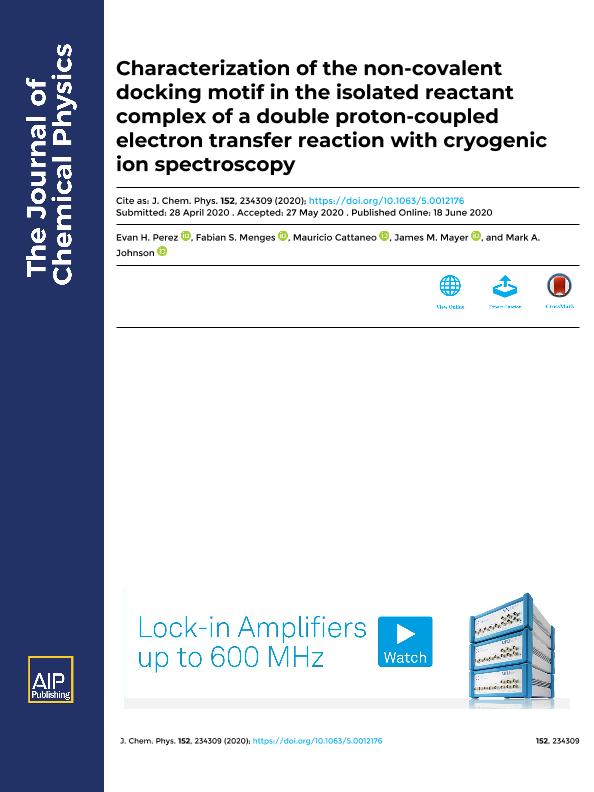Mostrar el registro sencillo del ítem
dc.contributor.author
Perez, Evan H.
dc.contributor.author
Menges, Fabian S.
dc.contributor.author
Cattaneo, Mauricio

dc.contributor.author
Mayer, James M.
dc.contributor.author
Johnson, Mark A.
dc.date.available
2021-10-04T14:52:33Z
dc.date.issued
2020-06
dc.identifier.citation
Perez, Evan H.; Menges, Fabian S.; Cattaneo, Mauricio; Mayer, James M.; Johnson, Mark A.; Characterization of the non-covalent docking motif in the isolated reactant complex of a double proton-coupled electron transfer reaction with cryogenic ion spectroscopy; American Institute of Physics; Journal of Chemical Physics; 152; 23; 6-2020; 1-8
dc.identifier.issn
0021-9606
dc.identifier.uri
http://hdl.handle.net/11336/142446
dc.description.abstract
The solution kinetics of a proton-coupled electron transfer reaction involving two-electron oxidation of a Ru compound with concomitant transfer of two protons to a quinone derivative have been interpreted to indicate the formation of a long-lived intermediate between the reactants. We characterize the ionic reactants, products, and an entrance channel reaction complex in the gas phase using high-resolution mass spectrometry augmented by cryogenic ion IR photodissociation spectroscopy. Collisional activation of this trapped entrance channel complex does not drive the reaction to products but rather yields dissociation back to reactants. Electronic structure calculations indicate that there are four low-lying isomeric forms of the non-covalently bound complex. Comparison of their predicted vibrational spectra with the observed band pattern indicates that the C=O groups of the ortho-quinone attach to protons on two different -NH2 groups of the reactant scaffold, exhibiting strong O-H-N contact motifs. Since collisional activation does not lead to the products observed in the liquid phase, these results indicate that the reaction most likely proceeds through reorientation of the H-atom donor ligand about the metal center.
dc.format
application/pdf
dc.language.iso
eng
dc.publisher
American Institute of Physics

dc.rights
info:eu-repo/semantics/openAccess
dc.rights.uri
https://creativecommons.org/licenses/by-nc-sa/2.5/ar/
dc.subject
PROTON-COUPLED ELECTRON TRANSFER
dc.subject
RUTHENIUM
dc.subject
MASS SPECTROMETRY
dc.subject
INFRARED SPECTROSCOPY
dc.subject.classification
Físico-Química, Ciencia de los Polímeros, Electroquímica

dc.subject.classification
Ciencias Químicas

dc.subject.classification
CIENCIAS NATURALES Y EXACTAS

dc.title
Characterization of the non-covalent docking motif in the isolated reactant complex of a double proton-coupled electron transfer reaction with cryogenic ion spectroscopy
dc.type
info:eu-repo/semantics/article
dc.type
info:ar-repo/semantics/artículo
dc.type
info:eu-repo/semantics/publishedVersion
dc.date.updated
2021-07-26T15:15:58Z
dc.journal.volume
152
dc.journal.number
23
dc.journal.pagination
1-8
dc.journal.pais
Estados Unidos

dc.journal.ciudad
New York
dc.description.fil
Fil: Perez, Evan H.. University of Yale; Estados Unidos
dc.description.fil
Fil: Menges, Fabian S.. University of Yale; Estados Unidos
dc.description.fil
Fil: Cattaneo, Mauricio. Consejo Nacional de Investigaciones Científicas y Técnicas. Centro Científico Tecnológico Conicet - Tucumán. Instituto de Química del Noroeste. Universidad Nacional de Tucumán. Facultad de Bioquímica, Química y Farmacia. Instituto de Química del Noroeste; Argentina
dc.description.fil
Fil: Mayer, James M.. University of Yale; Estados Unidos
dc.description.fil
Fil: Johnson, Mark A.. University of Yale; Estados Unidos
dc.journal.title
Journal of Chemical Physics

dc.relation.alternativeid
info:eu-repo/semantics/altIdentifier/doi/https://doi.org/10.1063/5.0012176
dc.relation.alternativeid
info:eu-repo/semantics/altIdentifier/url/https://aip.scitation.org/doi/10.1063/5.0012176
Archivos asociados
